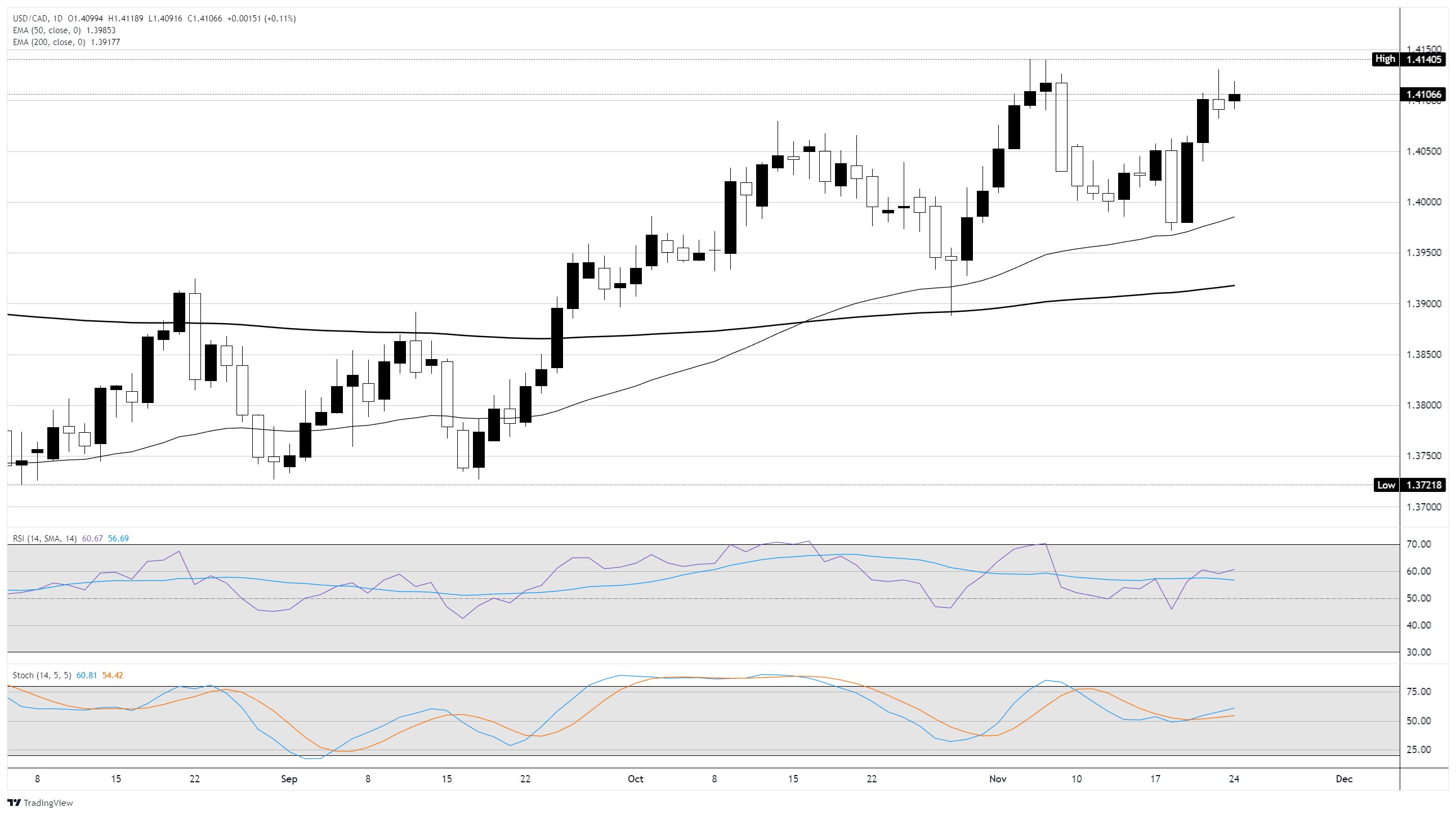Canadian Dollar remains defensive amid weak Crude Oil and data anticipation
- The Canadian Dollar eased back against the stubborn US Dollar on Monday.
- Battered Crude Oil markets are providing little support for the Loonie through the fourth quarter.
- Key Canadian GDP growth data due on Friday, US PPI inflation front-loaded on the week.
The Canadian Dollar (CAD) struggled to find upward momentum against the US Dollar (USD) on Monday, churning in an uneasy holding pattern near seven-month lows. Despite an early-week upswing in West Texas Intermediate (WTI) barrel bids on Monday, the Loonie is struggling to find support from near-term moves in energy markets as Crude Oil remains on the defensive.
Key Canadian Gross Domestic Product (GDP) growth figures are due this week, but Loonie traders will be forced to wait until Friday for any critical CAD-centric economic data releases. On the US side, the latest round of Producer Price Index (PPI) inflation updates will be released on Tuesday.
Daily digest market movers: Canadian Dollar continues to struggle amid a lack of meaningful data
- The Canadian Dollar remains on the defensive, stuck near seven-month lows against the US Dollar.
- CAD flows continue to track an overall downturn in Crude Oil markets as the Loonie maintains energy commodity exposure.
- Canadian Dollar markets are hunkered down for a long wait to Friday’s Canadian GDP print.
- US PPI inflation data is front-loaded onto Tuesday, markets expect a slight easing in producer-level inflation that specifically excludes imported goods exposed to tariffs.
- Domestic-only US PPI data is expected to have ticked slightly lower in September, while CAD GDP data is forecast to rebound on an annualized basis.
Canadian Dollar price forecast
USD/CAD continues to press higher after defending the rising 50-day Exponential Moving Average (EMA) near 1.3980. Buyers stepped in quickly after last week’s dip, forming a higher low that keeps the broader advance intact. Price is now testing the 1.4100 to 1.4150 zone, which has acted as stubborn resistance since early November. A daily close above 1.4150 would clear the recent ceiling and open the path toward the November high near 1.4200.
Momentum indicators support the bullish tone without flashing extremes. The relative strength index sits just above the midpoint and is rising, while the stochastic oscillator has turned higher from its mid-range. The 200-day EMA continues to slope upward under price, reinforcing the trend bias. As long as the pair holds above the recent higher low near 1.4000, buyers maintain control. A break below that level would be the first sign of fatigue.
USD/CAD daily chart

Canadian Dollar FAQs
The key factors driving the Canadian Dollar (CAD) are the level of interest rates set by the Bank of Canada (BoC), the price of Oil, Canada’s largest export, the health of its economy, inflation and the Trade Balance, which is the difference between the value of Canada’s exports versus its imports. Other factors include market sentiment – whether investors are taking on more risky assets (risk-on) or seeking safe-havens (risk-off) – with risk-on being CAD-positive. As its largest trading partner, the health of the US economy is also a key factor influencing the Canadian Dollar.
The Bank of Canada (BoC) has a significant influence on the Canadian Dollar by setting the level of interest rates that banks can lend to one another. This influences the level of interest rates for everyone. The main goal of the BoC is to maintain inflation at 1-3% by adjusting interest rates up or down. Relatively higher interest rates tend to be positive for the CAD. The Bank of Canada can also use quantitative easing and tightening to influence credit conditions, with the former CAD-negative and the latter CAD-positive.
The price of Oil is a key factor impacting the value of the Canadian Dollar. Petroleum is Canada’s biggest export, so Oil price tends to have an immediate impact on the CAD value. Generally, if Oil price rises CAD also goes up, as aggregate demand for the currency increases. The opposite is the case if the price of Oil falls. Higher Oil prices also tend to result in a greater likelihood of a positive Trade Balance, which is also supportive of the CAD.
While inflation had always traditionally been thought of as a negative factor for a currency since it lowers the value of money, the opposite has actually been the case in modern times with the relaxation of cross-border capital controls. Higher inflation tends to lead central banks to put up interest rates which attracts more capital inflows from global investors seeking a lucrative place to keep their money. This increases demand for the local currency, which in Canada’s case is the Canadian Dollar.
Macroeconomic data releases gauge the health of the economy and can have an impact on the Canadian Dollar. Indicators such as GDP, Manufacturing and Services PMIs, employment, and consumer sentiment surveys can all influence the direction of the CAD. A strong economy is good for the Canadian Dollar. Not only does it attract more foreign investment but it may encourage the Bank of Canada to put up interest rates, leading to a stronger currency. If economic data is weak, however, the CAD is likely to fall.
